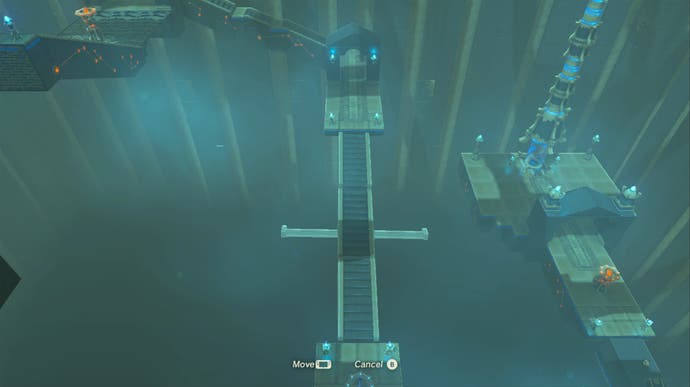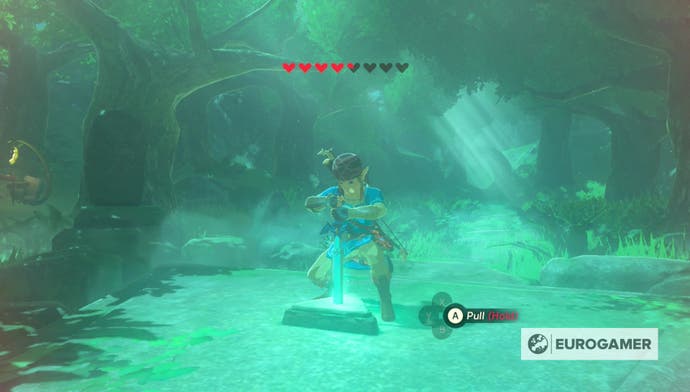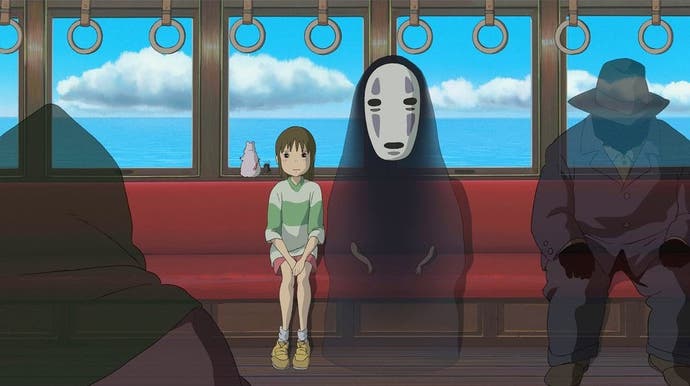Breath of the Wild's weapons are a window into the heart of video games
Spirited away.
I'm a little late to this particular party. Nintendo's E3 direct was a solid two weeks ago and the ensuing conversation, about whether or not the Currently Unnamed Sequel to The Legend of Zelda: Breath of the Wild should include the defining feature of The Legend of Zelda: Breath of the Wild, is now long finished, at least for now. But still, allow me to barrel on in anyway.
Breath of the Wild, if you're still unfamiliar, has weapons that irreparably break after you've used them for a little while, and that is annoying. In fact it's very annoying, and I feel like I'm as well-placed as any to say this because I wrote the majority of our 111-page guide to Breath of the Wild's shrines while using those weapons to get through them, and what became very clear, very quickly, was how an arsenal containing little more than a few sharpened twigs did not make my life any easier.
What also became pretty clear was the fact I really wasn't playing the game the way it was intended to be played, charging across each area in search of shrines and only shrines, only climbing walls, scaling towers, gliding or galloping through hills as a means of getting to the next one, treating the mechanics as a means to an end, as opposed to an end in themselves. When you treat games like this, as you often do, out of necessity, when writing their guides, you quickly learn to see through them: this is the game's cycle; this is how you break it. The question becomes one of how good the game is at convincing you, duping you, into sticking to that intended cycle, over the more efficient, less fun, break-the-cycle alternative.
In Breath of the Wild this cycle's quite obvious, and it's been written and litigated many times over. The intention is for you to explore, and for exploration to lead you to playing with its wonderfully systemic world, and for the two to perpetually coalesce. Everything feeds into the cycle: you use a weapon and it breaks, which leads you to look for more weapons by exploring, which leads you to a shrine that teaches you to solve problems with the game's everpresent physics and physics-defying toys, which rewards you with weapons, which break again, and also both stamina and, crucially, knowledge, which doesn't. Now you want to explore more because you liked the weapons you got as a reward, but you also know more about how to solve problems without them when they inevitably shatter, and have more stamina to boot, both of which help you traverse the world with more skill as you explore it in greater depth, finding more weapons, learning more skills, earning greater stamina, and on and on you go, gradually, with each revolution of the cycle, rolling back a little more of the fog that covers the world. Clever!

Even more clever is how this feeds into what Breath of the Wild is really about, what it actually is, in turn making another cycle of its own. Breath of the Wild is about exploration, ostensibly, which is obvious from its Wanderer Above the Sea of Fog cover art alone, but also its more literal, more brilliant mastery of the very Western AAA RPG, very player-as-conqueror, "See that mountain? You can climb it" philosophy.
At the same time it's distinctly un-Western AAA, in that it contains more than a millimetre of empty space: places that do nothing, give you nothing, serve no overt purpose at all other than to be between other spaces that do. This is Ma, the concept of "negative space" prevalent in traditional Japanese art and culture that has become, along with concepts like wabi sabi(transience and imperfection) and mono no aware (a gentle sadness at or sensitivity to that transience), something of a cliché now but are all, also, essential parts of what Breath of the Wild is trying to be. When you frame Breath of the Wild as a merging of ubiquitous RPG power fantasies and typically Japanese concepts - concepts that are especially tempting to fawn over, in the West, precisely because of their novel foreignness - it becomes easy to see why it's such a darling. You can put the "wow, open-world action game!" and "wow, Japanese stuff!" aside entirely and love it regardless, because the mix works: exploration, adventure, and empowerment are fun; an appreciation of quietness and reflection, and a proper rejection of vapid activity clutter, are long overdue, and can be appreciated - like when Roger Ebert spoke to Hayao Miyazaki about Spirited Away - without that appreciation becoming a kind of fawning. The two together are unequivocal magic.
The brittle weapons of Breath of the Wild, meanwhile, are the bridge between the two. It's often explained how they're an incentive to experiment, yes - a stick to beat you into using bombs and gravity and whatnot - but they're also the carrot of exploration, the reward for solving shrines or finding chests. And they break because, as Breath of the Wild is so keen to remind you at every turn, with its ruins, and its fallen heroes, and its shrine monks that sit waiting to die and a Hyrule as land-after-time: nothing is permanent.

What all of this says, then, is that anyone who doesn't like the brittle-boned weapons of Breath of the Wild is playing it wrong. That, if only you were to break loose from the shackles of weapon hoarding, you would finally be free to enjoy the game as intended, hitting boulders like golf balls and surfing the air into some bomb-bow-and-ice-block combo on another unsuspecting Hinox.
The problem is that isn't really true: charging across the game to complete all the shrines and nothing else is legitimate, as is hoarding weapons and using them and them alone in combat, without employing any fancy tablet magic to help. They might not be part of the design intention, the technical intention, of why a system is the way it is, but you might still find them fun. Shigeru Miyamoto, apparently, used the entirety of his time with a Breath of the Wild prototype to climb the trees.
"When we first presented this to Mr. Miyamoto, he spent about an hour just climbing trees," game director Hidemaro Fujibayashi said when telling the story to Kotaku. "We left little treats like rupees on the trees, but we also left other things in other places we thought he might go. But he just kept climbing trees. Up and down. And so we got to the point where we go, 'Do you want to look at other stuff?' But he just kept on going. Once [he] got out of the Shrine of Resurrection, he spent an hour just within a 25-50 meter radius outside of that cave just climbing trees."

Who am I to accuse Miyamoto of playing something wrong?! The point is intention is a nebulous thing. If you start closing off styles of play because they don't suit the attention of a designer, because they don't match with the meaning of a game, in particular, then you begin to miss something utterly essential about what the act of creating, and playing, and reacting to is really about. Here's Barry Jenkins, director of the Oscar-sweeping Moonlight, talking to Vulture about his process in making the remarkable series The Underground Railroad. The interviewer, Matt Zoller Seitz, has just asked Jenkins about his recurring use of sunlight:
"...we decided to embrace it. And, to be honest, use it. Not as a specific symbol and not not as a specific metaphor, necessarily, but as a way of showing that there were all these rampant examples of natural beauty, of the ravishing beauty of the Earth, of the land being so beautiful and my people also being beautiful - and yet, despite all that beauty, all these horrors were still allowed to manifest. All these horrors were still actively visited upon us."
A director - of a film, a show or a game, or anything else - can only take the piece of work so far, at which point it becomes a two-way thing, a tussle between viewer and director, player and designer.
Not a specific symbol, not a specific metaphor, necessarily. Zoller Seitz then mentions the use of very sunlight-like light on the series' underground trains, and how it seemed to mirror the almost holy sunlight used elsewhere. Jenkins agrees, but also clarifies:
"I also wanna say that I feel that to associate sunlight, or that sunlight color we're talking about, or that feeling of sun, with one kind of image and not another kind of image would have been false for us when we were making this. It would have been us creating a certain thematic or symbolic association, or a subjective position, as far as what this light means, or what it should mean."
"For the viewer?" Zoller Seitz asks. "Yes. And we didn't want to do that."
"So you want people to bring their own associations to it," Zoller Seitz says. Jenkins: "That's it, exactly."
Elsewhere, too, the point is reaffirmed. Jenkins talks about improvising shots around a particularly foggy spot on set, and completely rewriting a scene on the fly, after Joel Egerton improvised and picked up a gun he shouldn't have, because Egerton doing that worked even though Jenkins, in his words, would "never write something like what we did there." The point is intentionality has a limit. A director - of a film, a show or a game, or anything else - can only take the piece of work so far, at which point it becomes a two-way thing, a tussle between viewer and director, player and designer. A dialogue.
Beyond the intentionality of Breath of the Wild's weapons - to get you to adventure, experiment, pause, and feel melancholy - comes the input of the player, at which point you, not the designer, must carry things the rest of the way. The weapons could just as easily work the way they do in Breath of the Wild because of practicality, because it's just a more interesting solution than the typical RPG method - where the number of your level goes up, so the number of your enemies' level goes up, so the number of your weapons' level goes up, and really you all stay perfectly still, a treadmill system of fake satisfaction. Maybe avoiding that, reacting to challenges of the day, is all the Breath of the Wild team wanted to do, like Jenkins shooting around improv and playing with light. To say someone is playing it wrong is to give too much credit to a creator's intention. Intentionality is half the answer, with things like this, and practicality is likely the other.
Either way, it's all part of that game's magic cycle. Games are designed, then played, then talked about - sometimes indefinitely, as with these brilliant, ingenious and laughably feeble excuses for weapons - and all of these go two ways. They are all push and pull, all feeling-out and figuring-out. This is the heart of things: you have to figure it out, too.



